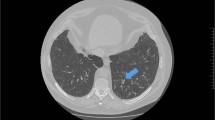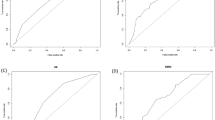Abstract
Clinical scenario
A 54 year-old man consults about a long-standing cough: his wife encouraged him to attend as she was tired of hearing him cough all the time. He is a bit vague about when it started, but it must be ‘nearly a year’. He has consulted his usual general practitioner about the cough three times. Eight months ago he presented with a ‘chesty’ cough associated with a feverish illness and an upper respiratory tract infection; he was prescribed a course of antibiotics which he thinks might have slightly improved the cough, though it did not fully resolve. Two subsequent consultations resulted in a further course of antibiotics and a trial of a salbutamol inhaler, neither of which appear to have made any difference. The clinical notes record that his chest was ‘clear’ at each of these consultations. He describes himself as ‘generally well’, though he has been tired recently which he attributes to the long hours he is working. He smoked for about 15 years but quit in his mid-thirties.
Similar content being viewed by others
Chronic cough is not a trivial problem and by the time a patient has been referred to a specialist cough clinic they (and their family) are likely to be thoroughly fed up! We know that persistent cough adversely impacts quality of life,1 and a significant proportion of patients referred to specialist clinics have measurable levels of psychomorbidity.2 Although females account for more than two-thirds of patients referred for specialist advice, the clinical scenario outlined in this case is not at all unusual. Asking directly about urinary incontinence during bouts of coughing is important as this is not always volunteered by the patient.
A systematic approach
The recommended approach to managing chronic cough is to assess each case systematically, beginning with history and physical examination and review of baseline investigations. CXR and spirometry should be performed as a minimum and in many countries can be easily undertaken in primary care [see Kaplan's perspective above] followed by additional diagnostic tests (not always available in primary care) and therapeutic trials based on the clinical features of the case.3–5
Although a commonly held position is that the clinical history offers little diagnostic information, my experience over the years has been that a carefully taken history is invaluable. Simply asking the patient to describe their cough is helpful; establishing whether the patient is actually coughing rather than ‘throat clearing’, for example, is important. In the case described above with the past history of smoking, chronic bronchitis and lung cancer are likely to have been carefully considered in primary care. Nonetheless, the threshold for bronchoscopy in a smoker with a normal chest radiograph and persistent cough is low. Other fairly obvious features in the history such as daily cough productive of large volume of mucus would suggest bronchiectasis and prompt a high resolution CT scan of the chest.
Patients often report worsening of their cough with respiratory tract infections (as in this case) but what is usually more disruptive for them is the daily aggravation of cough by relatively innocuous stimuli such as aerosols, scents and odours, a change in air temperature or even when simply talking or laughing. The term ‘cough hypersensitivity syndrome’ has been used to describe this clinical scenario,6 although doubt has been raised as to the validity of this as a distinct, but poorly understood clinical entity.7 Other important components in the history may be cough in association with the work place raising the possibility of occupational asthma, a seasonal pattern suggesting atopic cough, or co-existent symptoms of snoring and excessive daytime sleepiness suggesting obstructive sleep apnoea which is a well-recognised association.
However, the main value in taking a history is to identify typical and atypical symptoms that may help direct additional investigations and trials of therapy. The physical examination is frequently normal.
Further investigations and management strategies
Cough variant asthma and eosinophilic bronchitis are characterised by eosinophilic airway inflammation and both usually respond well to corticosteroids.8,9 The routine use of induced sputum for the assessment of airway inflammation in cough clinics has not been widely adopted. However, fractional exhaled nitric oxide (FeNO) is measured in all patients attending my specialist clinic. FeNO measurement is relatively simple, non-invasive and levels correlate well with eosinophilic airway inflammation.10 As FeNO levels are increased in asthmatic coughers and patients with eosinophilic bronchitis, the measurement of FeNO represents an attractive means of selecting patients for steroid treatment. However, there is no consensus on the optimal method of assessing airway inflammation, the dose and duration of oral corticosteroid trials, and the required length of treatment with inhaled corticosteroids.
The presence of reflux symptoms or prominent upper airway symptoms should prompt empirical treatment first, with further investigations withheld until the patient has had an adequate trial of therapy. Most patients referred to my specialist clinic have had numerous trials of therapy, but careful questioning establishes that many have had suboptimal doses of therapy often of inadequate duration and many admit to non-compliance. Until fairly recently, the treatment of gastro-oesophageal reflux disease (GORD) has focused mainly on the treatment of acid reflux and, based on fairly limited evidence, recommendations for high dose acid suppression for an extended duration (three months or longer) have been made. However, the notion that cough despite high dose acid suppression is not due to reflux is wrong. Recent findings suggest that non-acidic reflux episodes are strongly associated with episodes of cough.11 Multichannel intraluminal impedance (MII-pH) monitoring,12 which has the advantage of identifying and characterising both acidic and non-acidic reflux episodes is likely to supersede 24-hour ambulatory pH monitoring which offers little in the assessment of patients with cough.13 The value of prokinetic agents or treatments such as baclofen (which act directly on lower oesophageal tone) or surgical techniques such as laparascopic fundoplication in managing cough associated with volume reflux remain to be confirmed.
The association of cough with post nasal drip has been questioned,14 and unless the patient reports marked upper airway symptoms which have persisted despite an adequate trial of nasal therapy I would rarely refer for ear, nose and throat assessment. The recent adoption of the term upper airway cough syndrome (UACS) moves away from a symptom profile (postnasal drip) and towards likely causative factors (rhinitis or rhinosinusitis). Recommendations from North America for the treatment of UACS suggest sedating first-generation anti-histamines which although not universally available on prescription are preferred over newer agents.15 Intranasal corticosteroids are recommended but there is a lack of necessary detail as to the dose and duration of therapy.4
Unfortunately, up to 15% of patients with chronic cough remain unresolved despite numerous investigations and exhaustive trials of therapy.16 Patients with unexplained or idiopathic cough are known to benefit from cognitive behavioural therapy.17 The reality is that patients referred to specialist cough clinics rarely experience complete, long term resolution. I believe the best we can achieve with current treatments is to control the cough and I make this clear to all patients from the outset. New, more effective treatments for cough remain an unmet clinical need.
References
French CL, Irwin RS, Curley FJ, Krikorian CJ . Impact of chronic cough on quality of life. Arch Intern Med 1998;158:1657–61. http://dx.doi.org/10.1001/archinte.158.15.1657
McGarvey LP, Carton C, Gamble LA, et al. Prevalence of psychomorbidity among patients with chronic cough. Cough 2006;16;2:4
Morice AH, Fontana GA, Sovijarvi AR, et al. The diagnosis and management of chronic cough. Eur Respir J 2004;24:481–92.
Morice AH, McGarvey L, Pavord I for the British Thoracic Society Cough Guideline Group. Recommendations for the management of cough in adults. Thorax 2006;61 Suppl 1:i1–24.
Irwin RS, Boulet LP, Cloutier MM, et al. Managing cough as a defense mechanism and as a symptom. A consensus panel report of the American college of chest physicians. Chest 1998;114:133–81.
McGarvey L, McKeagney P, Polley L, MacMahon J, Costello RW . Are there clinical features of a sensitized cough reflex? Pulm Pharmacol Ther 2009;22:59–64.
Morice AH, McGarvey LP, Dicpinigaitis PV . Cough hypersensitivity syndrome is an important clinical concept: a pro/con debate. Lung 2012;190:3–9.
Corrao WM, Braman SS, Irwin RS . Chronic cough as the sole presenting manifestation of bronchial asthma. N Engl J Med 1979;300:633–7.
Gibson PG, Dolovich J, Denburg J, Ramsdale EH, Hargreave FE . Chronic cough: Eosinophilic bronchitis without asthma. Lancet 1989;1:1346–8.
Chatkin JM, Ansarin K, Silkoff PE, et al. Exhaled nitric oxide as a noninvasive assessment of chronic cough. Am J Respir Crit Care Med 1999;159:1810–13.
Patterson N, Mainie I, Rafferty G, et al. Nonacid reflux episodes reaching the pharynx are important factors associated with cough. J Clin Gastroenterol 2009;43:414–19.
Sifrim D, Holloway R, Silny J, et al. Acid, nonacid, and gas reflux in patients with gastroesophageal reflux disease during ambulatory 24-hour pH-impedance recordings. Gastroenterology 2001;120:1588–98.
Patterson RN, Johnston BT, MacMahon J, Heaney LG, McGarvey LP . Oesophageal pH monitoring is of limited value in the diagnosis of “reflux-cough”. Eur Respir J 2004;24:724–7.
Morice AH . Post-nasal drip syndrome—a symptom to be sniffed at? Pulm Pharmacol Ther 2004;17:343–5.
Pratter MR . Chronic upper airway cough syndrome secondary to rhinosinus diseases (previously referred to as postnasal drip syndrome): ACCP evidence-based clinical practice guidelines. Chest 2006;129(1Suppl):63S–71S.
McGarvey LPA, Ing AJ . Idiopathic cough: prevalence and underlying mechanisms. Pulm Pharmacol Ther 2004;17:435–9.
Vertigan AE, Theodoros DG, Gibson PG, Winkworth AL . Efficacy of speech pathology management for chronic cough: a randomised placebo controlled trial of treatment efficacy. Thorax 2006;61:1065–9.
Acknowledgements
Handling editor Hilary Pinnock
Author information
Authors and Affiliations
Corresponding author
Ethics declarations
Competing interests
The author declares that there are no conflicts of interest in relation to this article.
Rights and permissions
About this article
Cite this article
McGarvey, L. A 54 year-old man with a chronic cough — Following referral: a secondary care perspective from the UK. Prim Care Respir J 21, 345–346 (2012). https://doi.org/10.4104/pcrj.2012.00077
Received:
Accepted:
Published:
Issue Date:
DOI: https://doi.org/10.4104/pcrj.2012.00077



